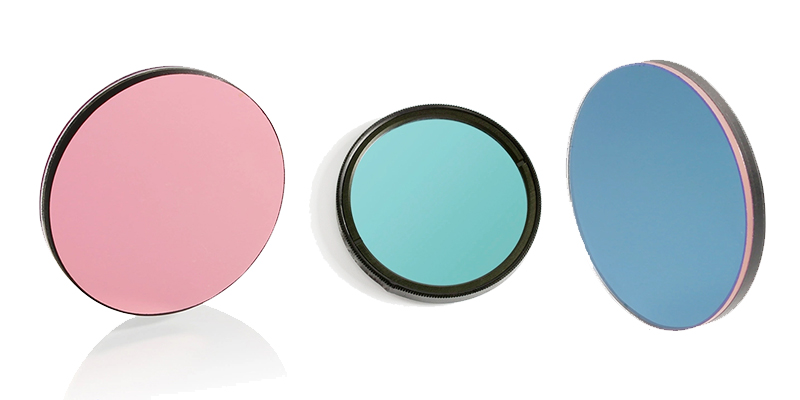
Classification of infrared filters
According to the structure and material of infrared filters, they can be classified into the following categories:

OEM infrared filter lens
Interferometric IR filters:
This kind of IR filters is made of multiple layers of films stacked on top of each other, each of which has a different refractive index and thickness. When the incident light is irradiated to this kind of filter, reflection and refraction will occur at the interface of each layer of film, thus forming an interference phenomenon. Only light of wavelengths that meet specific conditions can pass through the interferometric filter, while light of other wavelengths is reflected or absorbed. Interferometric infrared filters have the advantages of high transmittance, high selectivity, narrow bandwidth, good temperature stability, etc., but also have the disadvantages of complex production process, high cost, angle sensitivity.
Absorption infrared filter:
this infrared filter is made of certain materials that can absorb visible and ultraviolet light and transmit infrared light. These materials are usually some inorganic salts or organic dyes, such as mirror sulfide, silver iodide, iron oxide and so on. Absorption infrared filters have the advantages of simple production process, low cost, angle insensitivity, etc., but also have the disadvantages of low transmittance, poor selectivity, wide bandwidth, poor temperature stability.
Reflective infrared filter:
this kind of infrared filter is made of certain materials that can reflect visible and ultraviolet light and transmit infrared light. These materials are usually some metal or alloy, such as aluminum, silver, gold, etc.. Reflective infrared filters have the advantages of high transmittance, high selectivity and narrow bandwidth, but also have the disadvantages of complex production process, high cost and angle sensitivity.
Application of infrared filters
Infrared filters have a wide range of applications in many fields, for example:
Thermal imaging:
Thermal imaging is a technology that utilizes infrared radiation to detect the temperature distribution on the surface of an object. Thermal imagers usually need to be equipped with an infrared filter to block the interference of visible and ultraviolet light, thus improving image quality and accuracy.
Remote Sensing:
Remote sensing is a technique for observing the physical, chemical, or biological characteristics of the Earth’s surface or atmosphere from long distances using sensors carried by vehicles such as satellites or airplanes. Remote sensing sensors usually need to be equipped with an infrared filter to selectively receive infrared radiation in specific wavelength bands in order to obtain different types of information, such as vegetation cover, soil moisture, surface temperature, cloud thickness, and so on.
Medicine:
Medicine is a technology that utilizes infrared light to diagnose or treat human diseases. Medical instruments usually need to be equipped with an infrared filter to block interference from visible and ultraviolet light to improve the effectiveness of the measurement or treatment. For example, infrared thermography can be used to detect temperature anomalies on the surface of the body, infrared lasers can be used to cut or weld tissue, and infrared spectroscopy can be used to analyze the composition of body fluids or tissues.
Communication:
Communication is a technology that utilizes infrared light to transmit information. Communication devices usually need to be equipped with an infrared filter to block interference from visible and ultraviolet light, thus improving signal quality and security. For example, an infrared remote control can be used to control a TV or air conditioner, an infrared headset can be used to answer a phone call or listen to music, and an infrared network can be used to connect to a computer or printer.
The development trend of infrared filters
With the progress of science and technology and the needs of society, infrared filters are constantly developing and improving. The future of infrared filters may have the following trends:

optical lens widely use
Performance Improvement: The future infrared optical filters may have higher transmittance, stronger selectivity, narrower bandwidth, better temperature stability, and other performance indicators, thus improving the efficiency and precision in various applications.
Material innovation: Future IR filters may have a wider variety and combination of materials, resulting in more functionality and features. For example, flexible materials can make infrared filters become bendable and foldable, composite materials can make infrared filters with multi-band or multi-functional capabilities, and smart materials can make infrared filters with self-adaptive or adjustable characteristics.
Structural optimization: Future infrared filter lens may have simpler and more compact structures, thus reducing cost and weight and increasing portability and reliability. For example, miniaturization technology can make infrared filters become smaller and thinner, and integration technology can make infrared filters integrated with other devices.
optlenses
Related posts
What is the group velocity dispersion?
Cylinder Lens:The Function and Application Areas
What is The Interferometers?
Dichroic Mirror: A Reliable Assistant in Gemstone Identification



